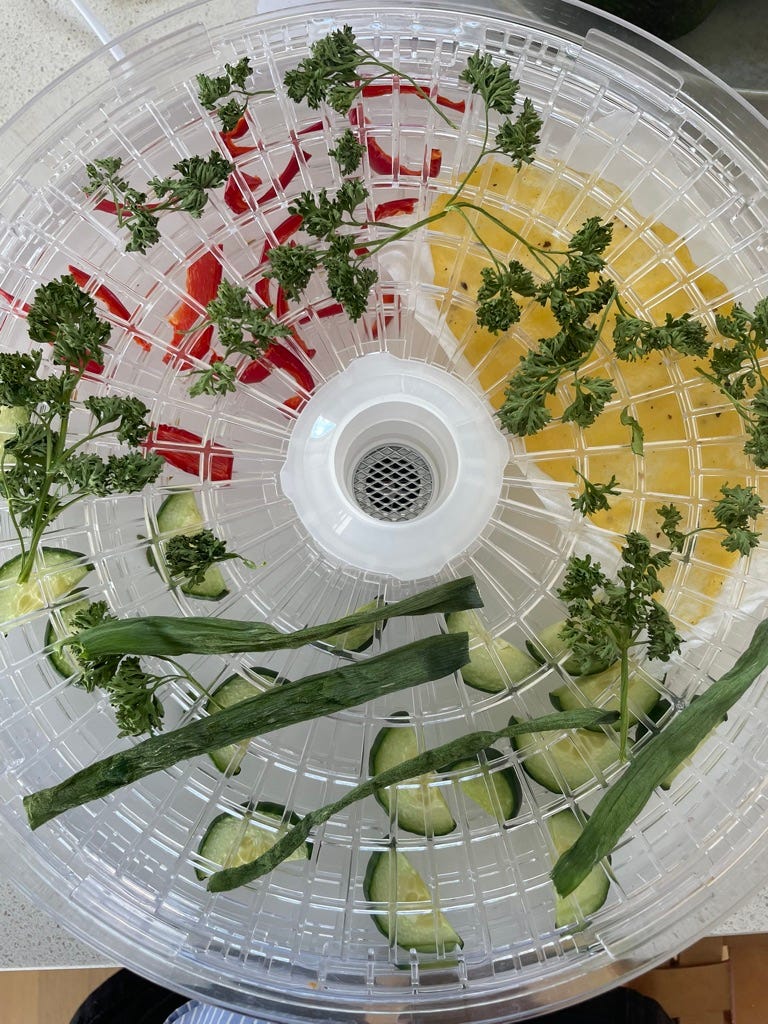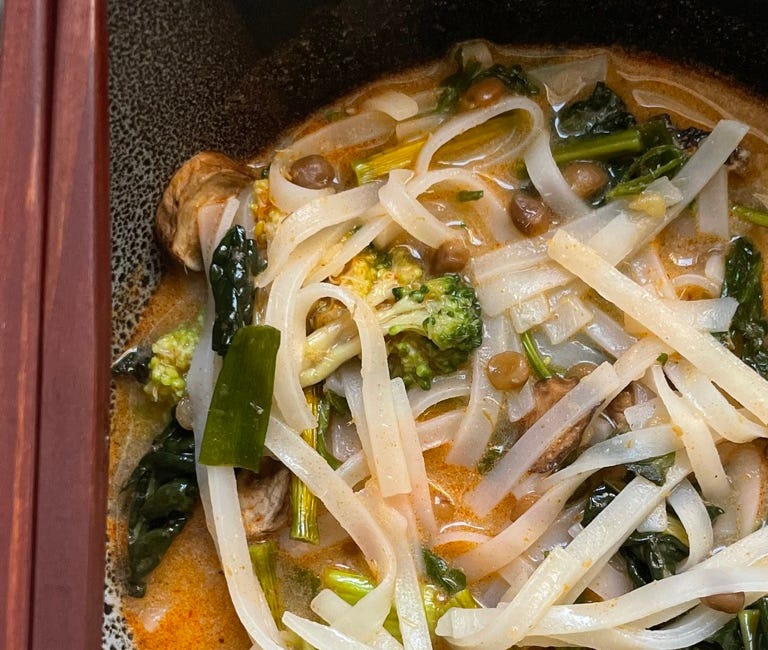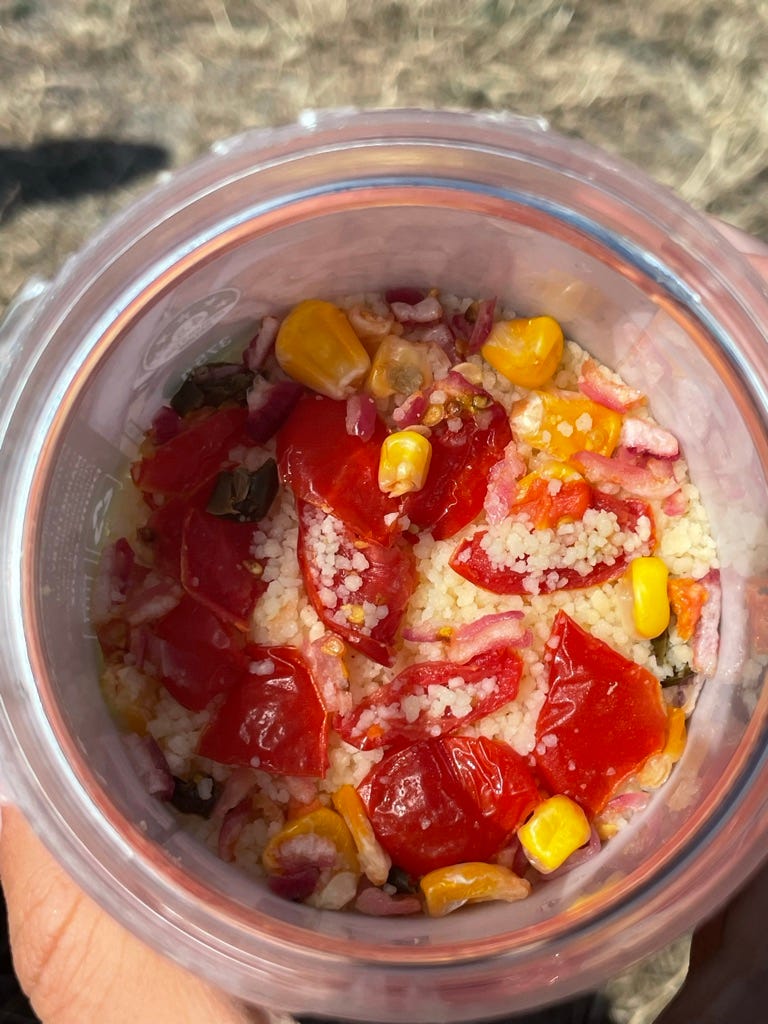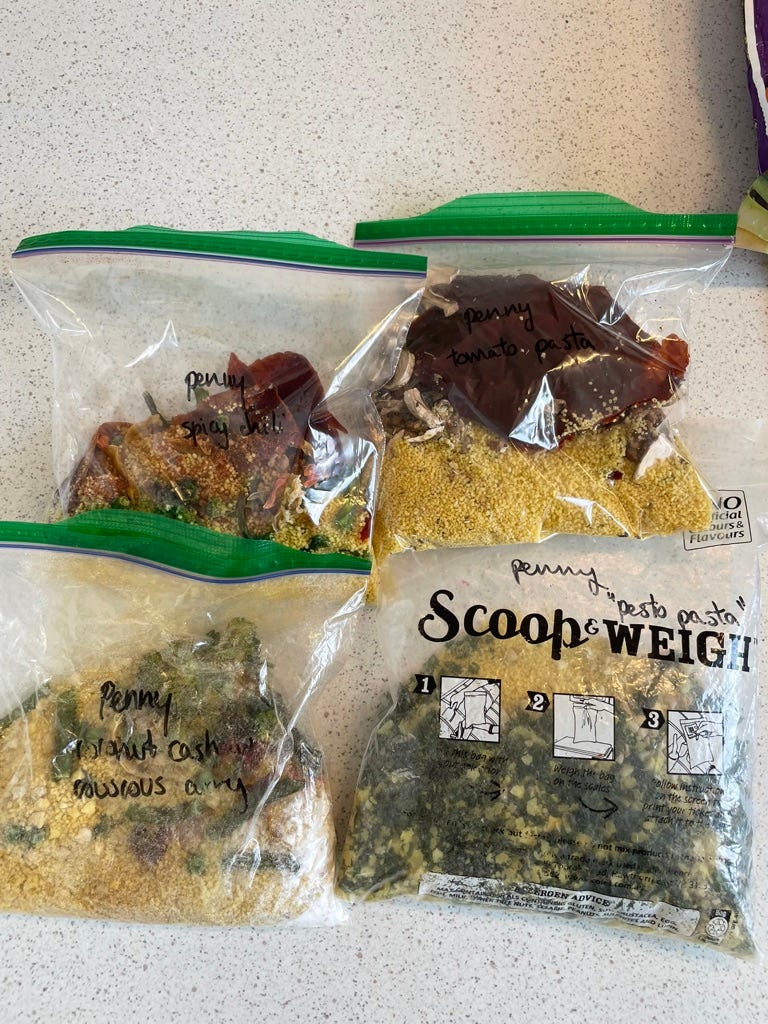welcome back to dehydration stations— my series on experimental hiking meals (a little detour from my usual baking adventures in penny’s kitchen!).
not interested in this series? you can unsubscribe from just dehydration stations by following the steps here. and don’t worry! the baking updates continue as normal on penny’s kitchen
store-bought dehydrated meals are a staple of the hiker’s meal plan. some are brilliant (i once drove 2hr just to buy more of the real meals wilderness stew), some are awful (not naming names), but most are just..ok.
as someone with a food intolerance, i’ve found the range of storebought meals can feel limited and a little repetitive. so i bought a dehydrator and started playing around with dehydrating my own ingredients, meals, and snacks. the goal was i want to eat what i eat at home, just on the trail!
but let’s back up - why do all hikers seem to eat dehydrated food anyway?
why dehydrate?
it sounds obvious but it’s worth defining: when we dehydrate food we are removing the moisture from it, and reducing the water content.
home dehydrators do this by running hot air over racks of food for extended periods of time (8-12 hours typically).
by reducing the water content we can dramatically decrease the weight while retaining the protein, fat and carb content of the food. for example, a typical apple might be 85% water. if we slice that apple and dehydrate it at 70C for 6 hours, we can reduce the weight of the same apple by 82% or a factor of 5.7. that is, a kilo of fresh apples can be dehydrated down to 175g dried apples while retaining all the delicious carbs and nutrients. this makes it possible to bring much larger quantities of “heavy” foods like fruits and vegetables without ending up with a 60kg pack weight.
we also can extend the lifespan of foods by dehydrating them. microorganisms like bacteria, yeast, and mould need water to grow and multiply. without enough water, they can’t survive or spoil the food. that’s why dehydrated meals can have a shelf life of years, and why jerky can be stored at room temperature.
dehydrated foods are also more convenient to cook when backpacking. all you need to do at camp is boil water, pour over the meal and let site for 10-15 minutes - no simmering, stirring, or dishes required!
where to start
so you’ve bought the dehydrator - now what?
you could do what i did, which is dehydrate the entire contents of the fridge, or you could see below for some super easy wins
low effort does not mean low reward! these are still some of my favourites to this day - whether i’m taking them hiking or not.
dried fruit
how to: thinly slice your favourite fruits, and dehydrate until dry to the touch and no longer tacky
flavours: my absolute favourites are watermelon, mango, and pear. the fruit flavour gets concentrated and they become almost like candy.
uses: use in trail mix, for snacking, or rehydrate in hot herbal tea for a fruit cup-like dessert
fruit leather
how to: blend your favourite fruits into a thick puree, spread on baking paper then dehydrate until leathery and dry to the touch
flavours: my favourites have been:
just blueberries
mango, pineapple & ginger
peach & raspberry
apple & cinnamon
uses: i love tearing up the fruit leather into little pieces and mixing them into my overnight oat packs. the fruit rehydrates overnight into delicious fruity compote pockets
herbs
dehydrating fresh herbs has to be one of the best ways to inspire some real campsite envy. there’s nothing like the smell of fresh(ish) coriander, basil, or parsley on day four of a hike to liven up your meal and make you feel like a real human eating real food!
how to: wash and dry your fresh herbs, and pick off the leaves. lay flat on the dehydrator and dry at 55C for 9 hours, or until crispy but still green. the weight will reduce by 90% or by a factor of 10.
uses:
dehydrate parsley in bulk, and mix with couscous for trail tabbouleh (recipe soon!)
dehydrate spring onion greens to jazz up instant ramen packets
dehydrate basil and mix with dehydrated pasta, sunflower seeds, and nutritional yeast or parmesan for pesto pasta
dehydrate coriander for tom kha noodle soup
dehydration stations: tom kha noodle soup
welcome back to my new series: dehydration stations! this is part two: tom kha noodle soup
tinned beans
yes, you can dehydrate beans! they rehydrate like a dream and can be a great cost-effective protein source for the trail
how to: drain and rinse your tinned legumes of choice, then spread evenly on the dehydrator trays. dry at 55C for 9-12 hours until totally dry and brittle-feeling
uses:
add extra protein to soups, pasta meals, or instant ramen
cold-soaked bean salads
blend, season, then dehydrate to make a bean paste and use as a filling for wraps (think indian-spiced lentil dosa, mexican-inspired burrito filling, or go italian with rosemary, white beans and lemon zest)
salad vegetables
salad vegetables (i.e. eaten raw) rehydrate really well with cold water and and bring some much needed freshness and crunch to meals
how to: slice and dice your vegetables into bite-size pieces, then dehydrate at 55C for 9-10 hours depending on their water content. you can see below the cucumber and capsicum took a little longer than carrots to dry fully.
uses:
dehydrate cherry tomatoes, capsicum, corn, black beans and coriander for trail burrito bowls, as pictured above!
dehydrate cucumber, tomatoes, parsley and couscous for trail tabbouleh
dehydrate spinach, bok choy, kale or your favourite green leaves and add a handful to everything
sauces
what sauces do you eat at home? i’d encourage you to go through your pantry and fridge and take a look at what you could potentially dehydrate and bring out with you. do note anything with dairy is not safe to dehydrate.
these can be absolute flavour bombs and have saved many a sad trail meal.
i’ve had success with the following:
sambal oolek
gochujang
tom yum paste (note: add citric acid afterwards to bring the vinegar tang back)
red curry paste
salsa
low-fat pesto (oil doesn’t dehydrate)
low-fat hummus
tinned passata
how to: spread the sauce evenly over baking paper and dehydrate at 55C for 6 hours or until completely dry. optional: blend into a fine powder.
uses:
add a fat pinch of any chilli sauce to any meals that need a little oomph
dehydrate hummus then rehydrate on trail for fancy little charcuterie board with crackers, hard cheese, salami, olives, and dried figs (wine optional, but what else do you do with the weight savings from the hummus?)
dehydrate tomato passata for instant pasta sauce, and mix with textured vegetable protein (TVP) for easy bolognese, chilli, or sloppy joes
dehydrating might sound a little intimidating at first, but once you start experimenting it’s incredibly satisfying - and the payoff on trail is huge!
you get a lighter pack, longer-lasting greens, and a chance to eat food that tastes like real food you cook at home!
next time i’ll dive into the medium effort ideas - a little cooking, a little preparation required, for when you have the time and energy.
if you try any of these ideas, i’d love to hear what you make!
see you out there,
penny 🥾✨








